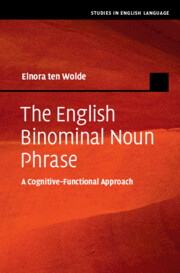Book contents
- The English Binominal Noun Phrase
- Studies in English Language
- The English Binominal Noun Phrase
- Copyright page
- Dedication
- Contents
- Figures
- Tables
- Acknowledgments
- Abbreviations
- Chapter 1 Introduction
- Part I Categorization
- Chapter 2 Of-binominal Classification
- Chapter 3 From Prototypical N+PP to Pseudo-partitive
- Chapter 4 The Evaluative Of-binominals
- Chapter 5 Three Case Studies: Cake, Beast, and Hell
- Part II Testing the Hypothesis
- Part III Theoretical Analysis
- Part IV Discussion
- References
- Index
Chapter 3 - From Prototypical N+PP to Pseudo-partitive
from Part I - Categorization
Published online by Cambridge University Press: 29 June 2023
- The English Binominal Noun Phrase
- Studies in English Language
- The English Binominal Noun Phrase
- Copyright page
- Dedication
- Contents
- Figures
- Tables
- Acknowledgments
- Abbreviations
- Chapter 1 Introduction
- Part I Categorization
- Chapter 2 Of-binominal Classification
- Chapter 3 From Prototypical N+PP to Pseudo-partitive
- Chapter 4 The Evaluative Of-binominals
- Chapter 5 Three Case Studies: Cake, Beast, and Hell
- Part II Testing the Hypothesis
- Part III Theoretical Analysis
- Part IV Discussion
- References
- Index
Summary
In this chapter, the classification criteria described in Chapter 2 are applied to the first three of-binominals in order to detail the formal and functional properties of each construction. The first construction is the prototypical N+PP (a whale of the north). This category represents an amalgamation of of-binominals all of which share syntactic features that could be regarded as characterizing canonical of-binominals in English, e.g. the first noun is the head, and the second noun is part of an NP embedded in a prepositional phrase functioning as a post-modifier. The second is the little researched head-classifier (a beast of prey). In this construction, the prepositional phrase qualifies the first noun; the second noun does not refer to a discourse referent and instead classifies noun1. This study distinguishes between two types of head-classifiers: taxonomic and intrinsic head-classifiers. The last construction is the pseudo-partitive (a cup of coffee). In this of-binominal, the second noun is head, and the first noun is a relational noun that measures/quantifies or indicates the shape of the second noun.
Keywords
- Type
- Chapter
- Information
- The English Binominal Noun PhraseA Cognitive-Functional Approach, pp. 28 - 62Publisher: Cambridge University PressPrint publication year: 2023

